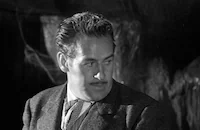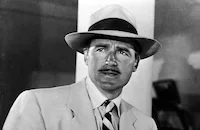The Way West

Brief Synopsis
Cast & Crew
Andrew V. Mclaglen
Kirk Douglas
Robert Mitchum
Richard Widmark
Lola Albright
Michael Witney
Film Details
Technical Specs

Synopsis
In 1843, a wagon train led by widowed Sen. William J. Tadlock leaves Independence, Missouri, for the long trek across the Oregon Trail. Foremost among the settlers are: Dick Summers, a seasoned trail scout with failing eyesight; farmer Lije Evans, his wife Rebecca, and their 16-year-old son, Brownie; newlyweds Johnnie and Amanda Mack; Sam Fairman and his wife, who are awaiting the birth of their child; and the slovenly McBee family. After several weeks on the trail, Johnnie, frustrated by his bride's frigidity, makes love with the flirtatious Mercy McBee during a drunken celebration; later that night, he shoots at what he thinks is a wolf and kills the son of a Sioux chief. Tadlock tries to evade the vengeful Indians by driving the wagon train into a buffalo herd, but the settlers are overtaken, and he is forced to hang Johnnie as retribution for the slaying. Mercy, pregnant with Johnnie's child, then accepts Brownie's offer of marriage. During a cattle crossing, Tadlock's son is killed in a stampede, and the senator is so disgusted by his own resulting emotional breakdown that he orders his Negro slave to whip him. In time, the settlers tire of the hardships and consider changing course from Oregon to California; to avert this, Tadlock fakes a smallpox scare, forcing the Army to order the train into the open plains. The lie is eventually exposed, and Lije attacks Tadlock savagely and assumes command. Eventually the caravan reaches its destination, with only a deep gorge remaining to be crossed. When Rebecca Evans shows the settlers Tadlock's design for a great city in Oregon, the ostracized leader is welcomed back into the group and permitted to supervise the lowering of people, animals, and dismantled wagons down the steep ravine. As the senator descends the cliff, however, Amanda Mack, driven to insanity by her husband's hanging, cuts the rope, and Tadlock plummets to his death. After his burial, the settlers journey down the Columbia River, leaving Summers behind.

Director

Andrew V. Mclaglen
Cast

Kirk Douglas

Robert Mitchum

Richard Widmark

Lola Albright
Michael Witney
Stubby Kaye

Sally Field
Katherine Justice
Michael Mcgreevey
Connie Sawyer

Harry Carey Jr.
Elisabeth Fraser

William Lundigan
Anne Barton

Roy Barcroft
Eve Mcveagh
Paul Lukather
Peggy Stewart
Stefan Arngrim
Jack Elam
Hal Lynch
Timothy Scott
John Mitchum
Roy Glenn

Patric Knowles
Nick Cravat
Gary Morris
Michael Lane
Eddie Little Sky
Michael Keep
Clarke Gordon

Ken Murray
Paul Wexler
Mitchell Schollars
Jack Coffer
Everett Creach
James Burk
Gary Mclarty
Crew
Newt Arnold
William H. Clothier
Tom Coleman
John Cutts
Mack David
Gordon Dawson
John Franco
Ted Haworth
Daniel W. Hays
Harold Hecht
Bronislaw Kaper
Bronislaw Kaper
Norma Koch
Mitch Lindemann
Otho Lovering
Lee Lukather
Ben Maddow
Frank Mccoy
Terry Morse Jr.
Hal Needham
Edwin O'donovan
André Previn
Robert Priestley
John Romness
Willie Schorr
Jack Solomon
Edna Taylor
Bud Thompson
Jean Udko
Hank Wynands
Tim Zinnemann

Videos
Movie Clip


Film Details
Technical Specs

Articles
The Way West
McLaglen learned from such icons as John Ford and John Wayne when he served as assistant director on movies like The Quiet Man (1952) and The High and the Mighty (1954). In his own movies, which include Shenandoah (1965), The Rare Breed (1966) and The Undefeated (1969), McLaglen seemed to be trying hard for a Fordian effect, but he came close only in his landscape compositions (and his frequent use of Wayne). There's a lot more to Ford, of course, such as a complexity and depth of feeling to the characters, and a unique mixing of the personal and the mythic.
In The Way West, Kirk Douglas plays a widowed senator and Robert Mitchum a trail scout with failing eyesight who lead a wagon train of pioneers from Missouri to Oregon. The property certainly had a good pedigree - it was based on a Pulitzer Prize-winning novel by A.B. Guthrie, Jr., who had written the screenplays for Shane (1953) and The Kentuckian (1955) as well as the novel of The Big Sky (1952). Sometimes these things look better on paper, however; while the budget was A-level ($5 million), the picture would gross only $1.67 million. Co-star Jack Elam later recalled the challenges of the complicated shoot: "Physically, it was as tough as it could possibly be. Working on the cliffs and in the sand. And then long days in the river, cold water, a lot of risks of drowning. Lowering wagons down the cliff, and we all had to take part in it. Some people landed in the hospital."
Douglas and Mitchum had appeared in The List of Adrian Messenger (1963) but not in any scenes together, making The Way West their first on-screen reunion since Out of the Past (1947). According to Lee Server's biography Robert Mitchum: Baby, I Don't Care, Douglas's ego created some tension. "Kirk was arrogant and rude to everybody," remembered assistant director Terry Morse. "He wanted everything his way." Co-star Harry Carey, Jr., concurred, calling Douglas "a pain in the neck. He tried to take over the thing at some point. Widmark got furious at it, very agitated. He screamed, 'You're not directing this go***mn movie!' Really raised hell with Douglas. Bob just laughed at it."
The easygoing Mitchum, in fact, ended up stealing the show from his fellow stars with a laid-back, relaxed performance, even though he was essentially just playing himself. McLaglen recalled how he cast Mitchum: "I went to have lunch with Mitchum and Harold Hecht, the producer. Kirk Douglas was signed to the part of the senator. And we flat-out said to Bob, 'Which part do you want? The husband or the scout? Take either part, whichever you want.' And all during lunch he wouldn't say, just 'I don't care; I don't care.' So what the hell, we gave him the part we thought he was best for, the scout. And he shrugged, and I'm awfully glad it worked out the way it did, because Widmark was perfect for the other part and Mitchum was perfect for the scout."
Mitchum's apathy, however, extended all the way to the location. Once there, he was at times more interested in fishing than acting. Terry Morse remembered that Mitchum would cast his fishing line even between takes when shooting along a river bank. "Sometimes he would get so concentrating on the fishing that he would walk away from the set, start moving along downstream. All of a sudden we'd be ready for him and he'd just disappeared. We had to assign a production assistant to keep an eye on him." In another sign of his laid-back nature, according to a separate biography, Mitchum bunked with the wranglers on location while Douglas and Widmark rented private houses.
Making her movie debut as a sagebrush tart is Sally Field. Best-known at the time as television's Gidget, she would go on to win two Academy Awards, for Norma Rae (1979) and Places in the Heart (1984). While Mitchum, Douglas and Widmark were all Oscar®-nominated over the years, none ever won the award.
Producer: Harold Hecht
Director: Andrew V. McLaglen
Screenplay: Mitch Lindemann, Ben Maddow, based on the novel by A. B. Guthrie, Jr.
Cinematography: William H. Clothier
Editing: Otho Lovering
Music: Bronislau Kaper
Art Direction: Ted Haworth
Cast: Kirk Douglas (Sen. William J. Tadlock), Robert Mitchum (Dick Summers), Richard Widmark (Lije Evans), Lola Albright (Rebecca Evans), Sally Field (Mercy McBee), Katherine Justice (Amanda Mack), Jack Elam (Preacher Weatherby), Stubby Kaye (Sam Fairman), William Lundigan (Michael Moynihan), Patric Knowles (Col. Grant).
C-122m. Letterboxed.
by Jeremy Arnold

The Way West
Quotes
Trivia
There was a minor helicopter crash on the set.
Notes
The Way West was based on the Pulitzer Prize-winning novel of the same name, the second book in a trilogy written by A. B. Guthrie, Jr. The trilogy began with The Big Sky, which RKO adapted for the screen in 1952 with director Howard Hawks and star Kirk Douglas; the last installment was These Thousand Hills, produced by Twentieth Century-Fox in 1959.

Miscellaneous Notes
Released in United States 1967
Feature film acting debut for actress Sally Field.
Released in USA on video.
Released in United States 1967













